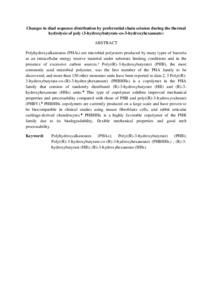Citation
Rajaratanam, Dhurga Devi and Ariffin, Hidayah and Hassan, Mohd Ali and Nishida, Haruo
(2016)
Changes in diad sequence distribution by preferential chain scission during the thermal hydrolysis of poly(3-hydroxybutyrate-co-3-hydroxyhexanoate).
Polymer Journal, 2016 (NA).
pp. 1-4.
ISSN 0032-3896; ESSN: 1349-0540
Abstract
Polyhydroxyalkanoates (PHAs) are microbial polyesters produced by many types of bacteria as an intracellular energy reserve material under substrate limiting conditions and in the presence of excessive carbon sources.¹ Poly((R)-3-hydroxybutyrate) (PHB), the most commonly used microbial polyester, was the first member of the PHA family to be discovered, and more than 150 other monomer units have been reported to date.2, 3 Poly((R)-3-hydroxybutyrate-co-(R)-3-hydroxyhexanoate) (PHBHHx) is a copolymer in the PHA family that consists of randomly distributed (R)-3-hydroxybutyrate (HB) and (R)-3-hydroxyhexanoate (HHx) units.⁴ This type of copolymer exhibits improved mechanical properties and processability compared with those of PHB and poly((R)-3-hydroxyvalerate) (PHBV).⁵ PHBHHx copolymers are currently produced on a large scale and have proven to be biocompatible in clinical studies using mouse fibroblasts cells, and rabbit articular cartilage-derived chondrocytes.⁶ PHBHHx is a highly favorable copolymer of the PHB family due to its biodegradability, flexible mechanical properties and good melt processability.
Download File
![[img]](http://psasir.upm.edu.my/55245/1.hassmallThumbnailVersion/Changes%20in%20diad%20sequence%20distribution%20by%20preferential%20chain%20scission%20during%20the%20thermal%20.pdf)  Preview |
|
Text (Abstract)
Changes in diad sequence distribution by preferential chain scission during the thermal .pdf
Download (116kB)
| Preview
|
|
Additional Metadata
Actions (login required)
 |
View Item |

